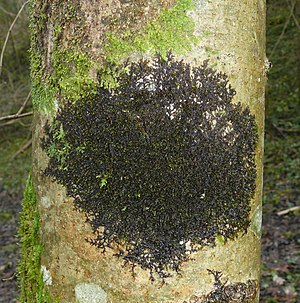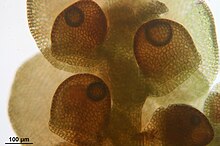Broad water sack moss
| Broad water sack moss | ||||||||||||
|---|---|---|---|---|---|---|---|---|---|---|---|---|

Broad water sack moss ( Frullania dilatata ) |
||||||||||||
| Systematics | ||||||||||||
|
||||||||||||
| Scientific name | ||||||||||||
| Frullania dilatata | ||||||||||||
| ( L. ) Dum. |
The broad water sack moss ( Frullania dilatata ) is a liverwort species from the Frullaniaceae family .
Identifying features
This type of moss grows in flat ceilings that are usually close to the substrate, from a few cm to over 20 cm in size. The color is dark red-brown to blackish, in shady areas also dark green. The stems are irregularly branched. With the rhizoid tufts on the underside, they adhere to the substrate. The individual branches are about 1 cm long and less than 1 mm wide. The position of the leaves is overshot: the upper edge of one leaf covers the lower edge of the next. The flank leaves are bilobed, with rounded to broadly oval and somewhat hollow upper lobes and about half the size of the lower lobes. The lower lobes are roughly the same length as they are wide and are usually transformed into helmet-shaped water sacs (name!). Forms with predominantly lanceolate lower lobes that are not converted into water sacs are called var. Anomala Corb. designated. The leaf cells have 3–4 oil bodies and are 20–25 µm in size in the middle of the leaf. Cell corners are knotty and thickened, in some cases also the cell walls. Lower leaves are a little wider than the stem and bilobed at the tip. The plants are dioecious . The female plants always wear perianthias that sit on the branch tips. Perianthia are rounded and rectangular and suddenly narrow into a short tube at the tip. Sporophytes are often formed.
Occurrence
The broad water sack moss grows mainly on the bark of deciduous trees, especially maple and ash , rarely on coniferous bark or on rock rich in bases. Light-rich locations in exposed forests, forest edges or on free-standing trees are preferred. The moss is widespread in Europe from the low-lying to the high-montane level, often common in Western Europe, less often in areas with a continental climate. There are other occurrences in Asia and North Africa.
Danger
Presumably due to air pollution, the moss was heavily decimated in some areas or even partially eradicated. There are significant decreases in stocks in the north and east of Germany. Richer occurrences of this type of moss indicate a relatively high level of air purity.
The broad water sack moss is parasitized by Octosporella erythrostigma (Pezizales) and Pithyella frullaniae (Helotiales), two small Ascomycetes.
literature
- Nebel, Philippi: Die Moose Baden-Württemberg Volume 3 . Ulmer Verlag, 1st edition, 2005, ISBN 3-8001-3278-8
- Jan-Peter Frahm , Wolfgang Frey , J. Döring: Moosflora . 4th edition, UTB Verlag, ISBN 3-8252-1250-5
- Ruprecht Düll / Barbara Düll-Wunder: Determine mosses easily and reliably . Quelle & Meyer Verlag, Wiebelsheim, ISBN 978-3-494-01427-2
Web links
Individual evidence
- ↑ Döbbeler P. 2004. Octosporella erythrostigma (Pezizales) and Pithyella frullaniae (Helotiales), two remarkable ascomycetes on Frullania dilatata. Feddes Repert 115: 5-14.
